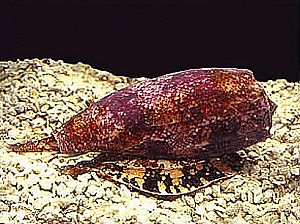Conus geographus facts for kids
Quick facts for kids Conus geographus |
|
|---|---|
 |
|
| A live specimen of Conus geographus | |
| Conservation status | |
| Scientific classification | |
| Synonyms | |
|
The Conus geographus, often called the geography cone or geographer cone, is a type of predatory cone snail. It lives in the warm, tropical reefs of the Indo-Pacific ocean. This snail hunts small fish using its powerful venom. While all cone snails use venom to catch their prey, the venom of the geography cone is strong enough to be dangerous to humans.
The variety Conus geographus var. rosea G. B. Sowerby I, 1833 is now known as Conus eldredi Morrison, 1955.
This species is also an important example for these groups of snails:
- Gastridium Modeer, 1793
- Rollus Montfort, 1810
- Utriculus Schumacher, 1817
Contents
What Does the Geography Cone Snail Look Like?
The geography cone snail has a wide, thin shell that is shaped like a cylinder. These snails can grow to be about 10 to 15 centimeters (4 to 6 inches) long. The smallest adult shells are around 43 millimeters (1.7 inches), and the largest can reach 166 millimeters (6.5 inches).
The shell's main color is usually pink or a purplish-white. It often has a mottled look, with cloudy, net-like patterns of brown or chocolate colors. These patterns usually form two uneven bands around the shell. This detailed brown-and-white design is very popular with people who collect shells.
The geography cone has a wide opening (called an aperture) that is purplish-white or pink. It also has many ridges or spines on its shoulder. The shell is covered with very fine lines that go around it, but these are usually hard to see except at the bottom. The top part of the shell, called the spire, is flat, has lines, and is crowned.
Compared to other cone snails, the geography cone's shell is noticeably wider and more rounded in the middle. Its top part (spire) is also flatter. The walls of its shell are thinner and lighter than other cone shells of similar size.
Where Do Geography Cone Snails Live?
Geography cone snails are quite common. You can find them in the Red Sea and the Indian Ocean. They live near places like Chagos, Réunion, Madagascar, Mauritius, Mozambique, and Tanzania.
They are native to the reefs of the Indo-Pacific region, but not Hawaii. In Australia, they are found off the Northern Territory, Queensland, and Western Australia.
How Do Geography Cone Snails Hunt?
C. geographus is a piscivore, which means it eats fish. It lives in the sand and mud of shallow reefs, where it hunts small fish. Like other cone snails, it uses a special harpoon-like tooth that is tipped with venom. This harpoon is shot into its prey. The harpoon stays attached to the snail's body by a long tube called a proboscis. Once the fish is stung, the snail pulls it in to eat it.
The Geography Cone Snail's Powerful Venom
The geography cone snail is very dangerous. You should be extremely careful if you ever see a live one. This snail has the most toxic sting known among all Conus species. There have been about three dozen reports of human deaths from its sting over the last 300 years.
The venom of the geography cone snail is a complex mix of hundreds of different toxins. It is delivered through a special harpoon-like tooth that shoots out from an extendable tube. There is no specific medicine (called an antivenom) for a cone snail sting. Treatment focuses on keeping the person alive until the toxins wear off.
The geography cone is sometimes jokingly called the "cigarette snail." This is a dark joke that suggests if you get stung, you'll only have enough time to smoke one cigarette before you die. In reality, even the most venomous cone snails take about one to five hours to kill a healthy human. However, getting medical help quickly is still very important, as without it, death is almost certain.
Scientists have found that some proteins in cone snail venom could be very useful as pain-killers. For example, Conantoxin-G comes from the venom of C. geographus. Only a small part (about 15-20 out of 100-200) of the venom's toxic parts are used for hunting. Scientists believe the other parts are for defense, meaning the snail mainly uses its venom to protect itself.
A Surprising Use of Insulin
Recent studies have shown something very interesting: C. geographus uses a type of insulin to stun its prey! This insulin is different from the snail's own insulin. It seems to be a simpler version of the insulin found in fish. When this venom enters a fish's gills, the fish goes into hypoglycaemic shock. This basically means its blood sugar drops very low, stunning it and making it easy for the snail to eat. This special poison mix has been called nirvana cabal. Along with the tulip cone snail (C. tulipa), no other known living creature uses its own biological insulin as a weapon.
Gallery









